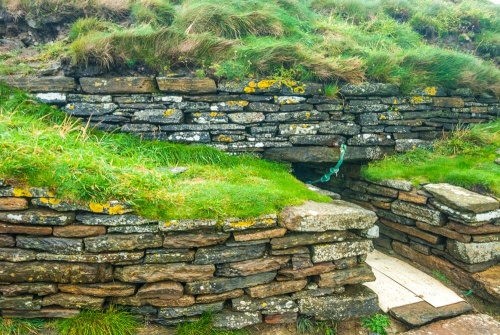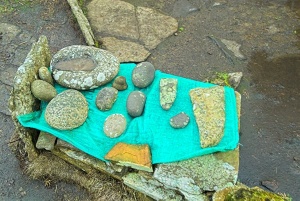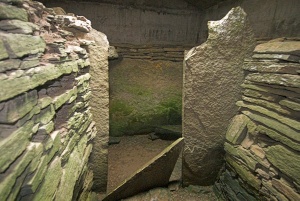
(Isbister Chambered Cairn)
Farmer Ronald Simison was just looking for some stones to use for fence posts. What he found instead was a 5000-year-old chambered cairn, complete with the bones of 340 humans. The chambered tomb, dubbed 'The Tomb of the Eagles' for the large number of white sea eagle bones found on the site, is unique in Orkney prehistoric sites in that the site is in private hands.
Most ancient sites are excavated and subsequently managed by, Historic Scotland, the government body charged with preserving archaeological sites in Scotland. When Mr Simison notified the authorities of his discovery, they were slow to act on the information. So slow, in fact, that several years passed and nothing had been done to preserve the site. Under the terms of the law governing ancient sites, the cairn became Mr Simson's property.
The Cairn

at the Burnt Mound site
Investigations have indicated that the entrance of the cairn may align with the rising sun at certain times of the year. This might suggest use of the cairn as a religious centre as well as a burial site.
Entering the cairn is an adventure. The entrance is by way of a three-metre long tunnel. Visitors can crawl - or, my favourite, waddle like a duck - to gain the interior, or use a low trolley to scoot along the passage in relative comfort.
Once inside, the cairn is surprisingly spacious, rising to 10 feet in height. Three low chambers lead off an elongated central passage which is further divided into stalls by vertical slabs. In one of the side chambers, several human skulls are arranged against the back wall, providing a slightly spooky reminder of what met the eyes of Mr Simison when he first opened the tomb.
The cairn was built around 3000 BCE and was in use for approximately 100 years. It seems clear that religious ceremonies were carried out in front of the tomb, ceremonies which perhaps involved animal sacrifice.
The large number of eagle bones found both inside and outside the tomb has led to speculation that the sea eagle was a kind of totem animal for the cairn builders. However recent research shows that the eagle bones were added to the site as much as 1000 years after it had ceased to be used by its builders. So we really do not know why the eagle bones were deposited here, but it does seem that the cairn was a site of special significance long after it had ceased to be used as a burial place.
The Burnt Mound
Halfway between the visitor centre and the chambered cairn are the remains of a Bronze Age site, sometimes called the Liddle Burnt Mound. An excavation in 1975 revealed the remains of a building, and beside it, a high mound of compacted stone and peat ash.
This 'burnt mound' was the result of many years accumulated residue from peat fires used to heat the building. The building itself was originally thought to be a house. Within the foundation walls are a hearth, beds, water reservoir and channels for running water.

Tomb of the Eagles for Families
Our children, aged 5 and 11 at the time of our visit, absolutely loved the Tomb of the Eagles. The fact that they were encouraged to handle exhibits in the visitor centre was a big plus, and the access to the tomb by way of a wheeled trolley added to the appeal. It was a bit nerve-wracking walking back to the visitor centre along the cliffs, which fall away quite steeply, but we kept a close eye on our little one and enjoyed the scenery immensely.
Getting there
Signposted off the A961 just north of Burwick, South Ronaldsay. There is a good-sized parking lot. Access to the burnt mound and cairn is on foot; the way is mostly level but a bit uneven, so good footwear is advised. There are two routes to the cairn; one leads inland, past the burnt mound, the other runs along the cliffs, providing a wonderfully scenic walk. The cairn is approximately 3/4 of a mile from the visitor centre.
Our Verdict
A top-notch visitor centre and guide commentary. The tomb itself was quite interesting, and the location was simply superb.
About Tomb-of-the-Eagles.htm
Address: Liddle,
St Margaret's Hope,
South Ronaldsay,
Orkney,
Highlands and Islands,
Scotland, KW17 2RW
Attraction Type: Prehistoric Site
Location: In the south-east corner of South Ronaldsay, 7 miles south of St Margaret's Hope. Signposted off the A961. Access to the tomb is an adventure; you lie on a wheeled dolly and pull yourself along the short passage with a rope.
Website: Tomb-of-the-Eagles.htm
Email: info@tomboftheeagles.co.uk
Location
map
OS: ND470846
Photo Credit: David Ross and Britain Express
HERITAGE
 We've 'tagged' this attraction information to help you find related historic attractions and learn more about major time periods mentioned.
We've 'tagged' this attraction information to help you find related historic attractions and learn more about major time periods mentioned.
Historic Time Periods:
Find other attractions tagged with:
Bronze Age (Architecture) - chambered tomb (Historical Reference) - Prehistoric (Time Period) -
NEARBY HISTORIC ATTRACTIONS
Heritage Rated from 1- 5 (low to exceptional) on historic interest
Duncansby Head Lighthouse and Sea Stacks - 8.1 miles (Countryside) ![]()
Churchill Barriers - 9.3 miles (Historic Building) ![]()
Hackness Martello Tower - 9.5 miles (Historic Building) ![]()
Italian Chapel - 10 miles (Historic Church) ![]()
Castle of Mey - 13.4 miles (Castle) ![]()
Mine Howe - 13.5 miles (Prehistoric Site) ![]()
Copinsay RSPB - 13.9 miles (Countryside) ![]()
Caithness Broch Centre - 14.1 miles (Museum) ![]()
Nearest Holiday Cottages to Tomb-of-the-Eagles.htm:
Nearby accommodation is calculated 'as the crow flies' from Tomb of the Eagles. 'Nearest' may involve a long drive up and down glens or, if you are near the coast, may include a ferry ride! Please check the property map to make sure the location is right for you.
John o Groats, Highlands and Islands
Sleeps: 12
Stay from: £2198.00 - 8036.00
Watten, Highlands and Islands
Sleeps: 3
Stay from: £284.00 - 1241.00
Lybster, Highlands and Islands
Sleeps: 4
Stay from: £325.00 - 1496.00
More self catering near Tomb-of-the-Eagles.htm








